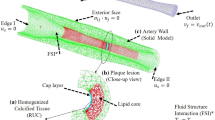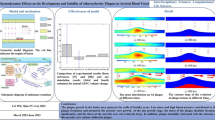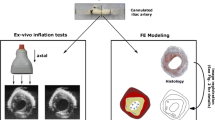Abstract
Traditionally, the degree of luminal obstruction has been used to assess the vulnerability of atherosclerotic plaques. However, recent studies have revealed that other factors such as plaque morphology, material properties of lesion components and blood pressure may contribute to the fracture of atherosclerotic plaques. The aim of this study was to investigate the mechanism of fracture of atherosclerotic plaques based on the mechanical stress distribution and fatigue analysis by means of numerical simulation. Realistic models of type V plaques were reconstructed based on histological images. Finite element method was used to determine mechanical stress distribution within the plaque. Assuming that crack propagation initiated at the sites of stress concentration, crack propagation due to pulsatile blood pressure was modeled. Results showed that crack propagation considerably changed the stress field within the plaque and in some cases led to initiation of secondary cracks. The lipid pool stiffness affected the location of crack formation and the rate and direction of crack propagation. Moreover, increasing the mean or pulse pressure decreased the number of cycles to rupture. It is suggested that crack propagation analysis can lead to a better recognition of factors involved in plaque rupture and more accurate determination of vulnerable plaques.




Similar content being viewed by others
References
Akyildiz AC, Speelman L, Gijsen FJ (2014) Mechanical properties of human atherosclerotic intima tissue. J Biomech 47:773–783
Bank A, Versluis A, Dodge S, Douglas W (2000) Atherosclerotic plaque rupture: a fatigue process? Med Hypotheses 55:480–484
Bluestein D, Alemu Y, Avrahami I, Gharib M, Dumont K, Ricotta JJ, Einav S (2008) Influence of microcalcifications on vulnerable plaque mechanics using FSI modeling. J Biomech 41:1111–1118
Born GVR, Richardson PD (1990) Mechanical properties of human atherosclerotic lesions. In: Glacove S, Newman WP, Schaffer SA (eds) Pathobiology of the human atherosclerotic plaque. Springer, New York, pp 413–423
Broek D (1986) Elementary engineering fracture mechanics. Springer, New York
Brown BG, Zhao X-Q, Sacco DE, Albers JJ (1993) Lipid lowering and plaque regression. New insights into prevention of plaque disruption and clinical events in coronary disease. Circulation 87:1781–1791
Brown AJ, Teng Z, Evans PC, Gillard JH, Samady H, Bennett MR (2016) Role of biomechanical forces in the natural history of coronary atherosclerosis. Nat Rev Cardiol 13(4):210–220. doi:10.1038/nrcardio.2015.203
Burke AP, Tavora F (2010) Practical cardiovascular pathology. Lippincott Williams & Wilkins, Philadelphia
Chau AH, Chan RC, Shishkov M, MacNeill B, Iftimia N, Tearney GJ, Kamm RD, Bouma BE, Kaazempur-Mofrad MR (2004) Mechanical analysis of atherosclerotic plaques based on optical coherence tomography. Ann Biomed Eng 32:1494–1503
Cheng GC, Loree HM, Kamm RD, Fishbein MC, Lee RT (1993) Distribution of circumferential stress in ruptured and stable atherosclerotic lesions. A structural analysis with histopathological correlation. Circulation 87:1179–1187
Falk E, Shah PK, Fuster V (1995) Coronary plaque disruption. Circulation 92:657–671
Finet G, Ohayon J, Rioufol G (2004) Biomechanical interaction between cap thickness, lipid core composition and blood pressure in vulnerable coronary plaque: impact on stability or instability. Coron Artery Dis 15:13–20
Gao H, Long Q (2008) Effects of varied lipid core volume and fibrous cap thickness on stress distribution in carotid arterial plaques. J Biomech 41:3053–3059
Gilpin CM (2005) Cyclic loading of porcine coronary arteries. Master thesis, Georgia Institute of Technology, GA
Hallow KM, Taylor WR, Rachev A, Vito RP (2009) Markers of inflammation collocate with increased wall stress in human coronary arterial plaque. Biomech Model Mechanobiol 8:473–486
Holzapfel GA, Sommer G, Regitnig P (2004) Anisotropic mechanical properties of tissue components in human atherosclerotic plaques. J Biomech Eng 126:657–665
Huang Y, Teng Z, Sadat U, He J, Graves MJ, Gillard JH (2013) In vivo MRI-based simulation of fatigue process: a possible trigger for human carotid atherosclerotic plaque rupture. Biomed Eng Online 12:36
Huang Y, Teng Z, Sadat U, Graves MJ, Bennett MR, Gillard JH (2014) The influence of computational strategy on prediction of mechanical stress in carotid atherosclerotic plaques: comparison of 2D structure-only, 3D structure-only, one-way and fully coupled fluid-structure interaction analyses. J Biomech 47:1465–1471
Kaazempur-Mofrad M, Wada S, Myers J, Ethier C (2005) Mass transport and fluid flow in stenotic arteries: axisymmetric and asymmetric models. Int J Heat Mass Transf 48:4510–4517
Kannel WB (1996) Blood pressure as a cardiovascular risk factor: prevention and treatment. JAMA 275:1571–1576
Kock SA, Nygaard JV, Eldrup N, Fründ E-T, Klærke A, Paaske WP, Falk E, Kim WY (2008) Mechanical stresses in carotid plaques using MRI-based fluid–structure interaction models. J Biomech 41:1651–1658
Ku DN, Giddens DP, Zarins CK, Glagov S (1985) Pulsatile flow and atherosclerosis in the human carotid bifurcation. Positive correlation between plaque location and low oscillating shear stress. Arterioscler Thromb Vasc Biol 5:293–302
Leach JR, Rayz VL, Soares B, Wintermark M, Mofrad MR, Saloner D (2010) Carotid atheroma rupture observed in vivo and FSI-predicted stress distribution based on pre-rupture imaging. Ann Biomed Eng 38:2748–2765
Loree HM, Kamm R, Stringfellow R, Lee R (1992) Effects of fibrous cap thickness on peak circumferential stress in model atherosclerotic vessels. Circ Res 71:850–858
Madhavan S, Ooi WL, Cohen H, Alderman MH (1994) Relation of pulse pressure and blood pressure reduction to the incidence of myocardial infarction. Hypertension 23:395–401
Naghavi M, Libby P, Falk E, Casscells SW, Litovsky S, Rumberger J, Badimon JJ, Stefanadis C, Moreno P, Pasterkamp G (2003) From vulnerable plaque to vulnerable patient a call for new definitions and risk assessment strategies: part I. Circulation 108:1664–1672
Ohayon J, Dubreuil O, Tracqui P, Le floc’h S, Rioufol G, Chalabreysse L, Thivolet F, Pettigrew RI, Finet G (2007) Influence of residual stress/strain on the biomechanical stability of vulnerable coronary plaques: potential impact for evaluating the risk of plaque rupture. Am J Physiol Heart Circ Physiol 293:H1987–H1996
Pagiatakis C, Galaz R, Tardif J-C, Mongrain R (2015) A comparison between the principal stress direction and collagen fiber orientation in coronary atherosclerotic plaque fibrous caps. Med Biol Eng Comput 53:545–555
Papaioannou TG, Karatzis EN, Vavuranakis M, Lekakis JP, Stefanadis C (2006) Assessment of vascular wall shear stress and implications for atherosclerotic disease. Int J Cardiol 113:12–18
Pei X, Wu B, Li Z-Y (2013) Fatigue crack propagation analysis of plaque rupture. J Biomech Eng 135:101003
Qiu Y, Tarbell JM (2000) Interaction between wall shear stress and circumferential strain affects endothelial cell biochemical production. J Vasc Res 37:147–157
Richardson PD (2002) Biomechanics of plaque rupture: progress, problems, and new frontiers. Ann Biomed Eng 30:524–536
Richardson PD, Davies M, Born G (1989) Influence of plaque configuration and stress distribution on fissuring of coronary atherosclerotic plaques. Lancet 334:941–944
Rioufol G, Finet G, Ginon I, Andre-Fouet X, Rossi R, Vialle E, Desjoyaux E, Convert G, Huret J, Tabib A (2002) Multiple atherosclerotic plaque rupture in acute coronary syndrome a three-vessel intravascular ultrasound study. Circulation 106:804–808
Sadat U, Teng Z, Young VE, Walsh SR, Li ZY, Graves MJ, Varty K, Gillard JH (2010) Association between biomechanical structural stresses of atherosclerotic carotid plaques and subsequent ischaemic cerebrovascular events—a longitudinal in vivo magnetic resonance imaging-based finite element study. Eur J Vasc Endovasc Surg 40:485–491. doi:10.1016/j.ejvs.2010.07.015
Sangid MD (2013) The physics of fatigue crack initiation. Int J Fatigue 57:58–72
Stary HC, Chandler AB, Dinsmore RE, Fuster V, Glagov S, Insull W, Rosenfeld ME, Schwartz CJ, Wagner WD, Wissler RW (1995) A definition of advanced types of atherosclerotic lesions and a histological classification of atherosclerosis A report from the Committee on Vascular Lesions of the Council on Arteriosclerosis, American Heart Association. Circulation 92:1355–1374
Tang D, Yang C, Zheng J, Woodard PK, Sicard GA, Saffitz JE, Yuan C (2004) 3D MRI-based multicomponent FSI models for atherosclerotic plaques. Ann Biomed Eng 32:947–960
Tang D, Yang C, Mondal S, Liu F, Canton G, Hatsukami TS, Yuan C (2008) A negative correlation between human carotid atherosclerotic plaque progression and plaque wall stress: in vivo MRI-based 2D/3D FSI models. J Biomech 41:727–736
Topoleski LT, Salunke N, Humphrey J, Mergner W (1997) Composition-and history-dependent radial compressive behavior of human atherosclerotic plaque. J Biomed Mater Res 35:117–127
Vengrenyuk Y, Carlier S, Xanthos S, Cardoso L, Ganatos P, Virmani R, Einav S, Gilchrist L, Weinbaum S (2006) A hypothesis for vulnerable plaque rupture due to stress-induced debonding around cellular microcalcifications in thin fibrous caps. Proc Natl Acad Sci 103:14678–14683
Veress AI, Weiss JA, Gullberg GT, Vince DG, Rabbitt RD (2002) Strain measurement in coronary arteries using intravascular ultrasound and deformable images. J Biomech Eng 124:734–741
Versluis A, Bank AJ, Douglas WH (2006) Fatigue and plaque rupture in myocardial infarction. J Biomech 39:339–347
Author information
Authors and Affiliations
Corresponding author
Rights and permissions
About this article
Cite this article
Rezvani-Sharif, A., Tafazzoli-Shadpour, M., Kazemi-Saleh, D. et al. Stress analysis of fracture of atherosclerotic plaques: crack propagation modeling. Med Biol Eng Comput 55, 1389–1400 (2017). https://doi.org/10.1007/s11517-016-1600-z
Received:
Accepted:
Published:
Issue Date:
DOI: https://doi.org/10.1007/s11517-016-1600-z




